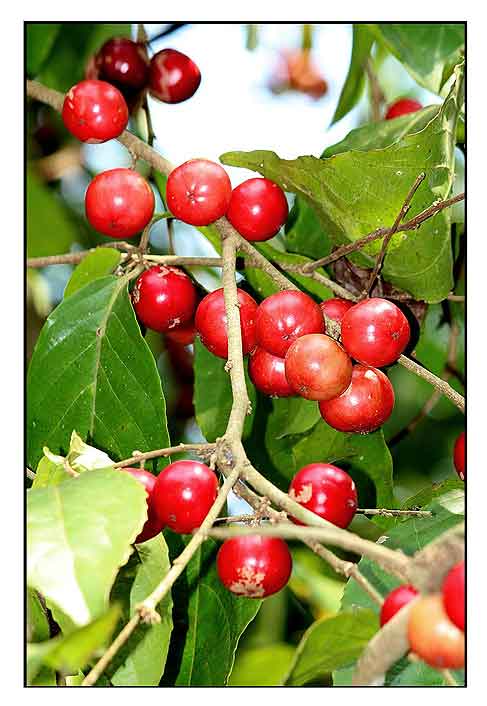 Gen info Gen info
- Genus Flacourtia was named after Etienne de Flacourt, former governor of Madagascar (1607-1660).
- Species epithet 'inermis' derives from Latin, meaning 'unarmed', referring to the absence of thorns in the plant. (11)
- The "lovi-lovi" (Flacourtia inermis) was introduced from Sumatra, Indonesia by Dr. Roberto Coronel in 1987. The plant was planted and fruited for the first time in 2002.
(8)
Botany
Flacourtia inermis is a medium-sized spineless tree that may grow up to 15 meters (49 feet). The mature leaves are oblong and elliptic in shape and glossy on the upper side, with a toothed margin. They are about 8 to 20 centimeters (3 to 8 inches) long and 3 to 15 cm (1 to 6 in) wide. The young leaves are bright orange to reddish in color, turning green as they mature. The fruits are produced in bunches and resemble cherries. The fruit is round and shiny, turning from light green to a deep red color upon ripening. Each fruit measures 1 to 3 cm (1⁄2 to 1+1⁄4 in) in diameter. The flesh is crunchy but sour and acidic in taste. (2)
Distribution
- Introduced from Indonesia.
- Ornamental cultivation for its beautiful foliage and bright red colored fruit.
Constituents
- Study of fruit juice yielded five caffeoylquinic acid derivatives: methyl chlorogenate (1), methyl 5-O-caffeoylquinate (2), methyl 4-O-caffeoylquinate (3). n-butyl chlorogenate (4), n-butyl 5-O-caffeoylquiinate (5) and a rare phenolic glucoside (rel)-6α-benzoyloxy-1α,2α-dihydroxy-5-oxocyclohex-3-enecarboxylic acid 2-(6-O-benzoyl-ß-D-glucopyranosyl)-5-hydroxybenzyl ester (6), together with quinic acid (7) and malic acid (8). (see study below) (6)
- Fresh fruit yielded polyphenolic content of 1.28 g GAE/100 g and anthocyanin content of 108 mg cyanidin-3-glucoside equivalents/100 g. (see study below) (7)
- Study of fruit yielded anthocyanin level of 17.99 mg/L. Antioxidant activity by DPPH showed IC50 of 50.01 g/L.
(10)
Properties
Studies have suggest antioxidant, antibacterial, antifungal, antiprotozoal, antidiabetic properties.
Parts used
Fruits, roots, leaves.
Uses
Edibility
- Fruits are edible raw or cooked; usually not eaten fresh but used in making jams, preserves and syrups. When ripe, the fruits have a sour and astringent taste.
- In Indonesia, cooked fruits used in making 'rujak' (a mix of fruit, chili sauce and peanut) and ;'asinan' (mixed vegetable with chili).
Folkloric
- No reported folkloric medicinal use in the Philippines.
- Fruit juice used to treat diarrhea, vomiting, nausea, and throat pain.
- Poultice of roots applied to wounds, sores, and sore throats. Leaf and root infusions used to treat stomach distention. (11)
Others
- Dye: Study on anthocyanin content suggests potential as source of natural dye from fruit peels. (see study below)
- Wood: In Java, wood used to pound rice because of hardness of the wood. (11)
Studies
• Antiifungal / Fruits: Study evaluated an acetonic extract of F. inermis fruit for antifungal activity against opportunistic human pathogens such as Aspergillus flavus, A. niger, Mucor ramosissimus and Chrysosporium species. Results showed highest activity against A. fumigatus with average inhibition zone of 47 mm, and least against A. niger with mean inhibition zone of 30 mm. (3)
• Antibacterial Against MDR Bacteria / Fruits: Study isolated an antibacterial phenolic compound. 2,3-dihydroxybenzoic acid from the fruit extract of F. inermis. The compound showed effective antibacterial activity multidrug resistant MTCC bacteria strains, with increased susceptibility with Serratia marcesens, followed by E. coli, P. aeruginosa, S. aureus, and K. pneumonia. (4)
• Antiprotozoal / Fruits: Study showed the purified compound from fruit extract, 2,3-dihydroxybenzoic acid at concentration of 2.5 mg/ml was lethal to fresh water protozoa and rectal ciliates of frog. (5)
• Radical Scavenging Activity / Fruit Juice: Study of fruit juice yielded five caffeoylquinic acid derivatives: methyl chlorogenate (1), methyl 5-O-caffeoylquinate (2), methyl 4-O-caffeoylquinate (3). n-butyl chlorogenate (4), n-butyl 5-O-caffeoylquiinate (5) and a rare phenolic glucoside (rel)-6α-benzoyloxy-1α,2α-dihydroxy-5-oxocyclohex-3-enecarboxylic acid 2-(6-O-benzoyl-ß-D-glucopyranosyl)-5-hydroxybenzyl ester (6), together with quinic acid (7) and malic acid (8). Compounds 1, 2, 4, and 5 showed strong radical scavenging properties on DPPH assay. (6)
• Malic Acid / Antioxidant / Glucosidase, Amylase, Lipase Inhibiting Activities / Fruits: Study of fruit extracts for biologic activity found the fruits to be a rich source of phenolics and anthocyanins. Fresh fruit yielded polyphenolic content of 1.28 g GAE/100 g and anthocyanin content of 108 mg cyanidin-3-glucoside equivalents/100 g. EtOAc showed moderate antioxidant activity in DPPH assay with IC50 66,2 ppm. EtOAc and MeOH extracts showed inhibitory activities towards α-glucosidase, α-amylase, and lipase enzymes with IC50s ranging from 549-710, 1021-1949, and 1290 to 2096 ppm, respectively. The active principle was identified as (S)-malic acid. Results suggest a potential for use as health food or nutritional supplement and for controlling blood glucose level. (7)
• Anthocyanin / Potential as Dye Agent / Fruit Peel: Study evaluated the anthocyanin content of F. inermis and its ultraviolet-visible absorption potential as a dye agent. Total anthocyanin content of peel was 10.35 mg/100 g. Results suggest anthocyanidine-3-glucosde is a potential natural dye obtained from plants. (9)
Availability
Wild-crafted.
Ornamental cultivation.
Seeds in the cybermarket.
|

![]()




